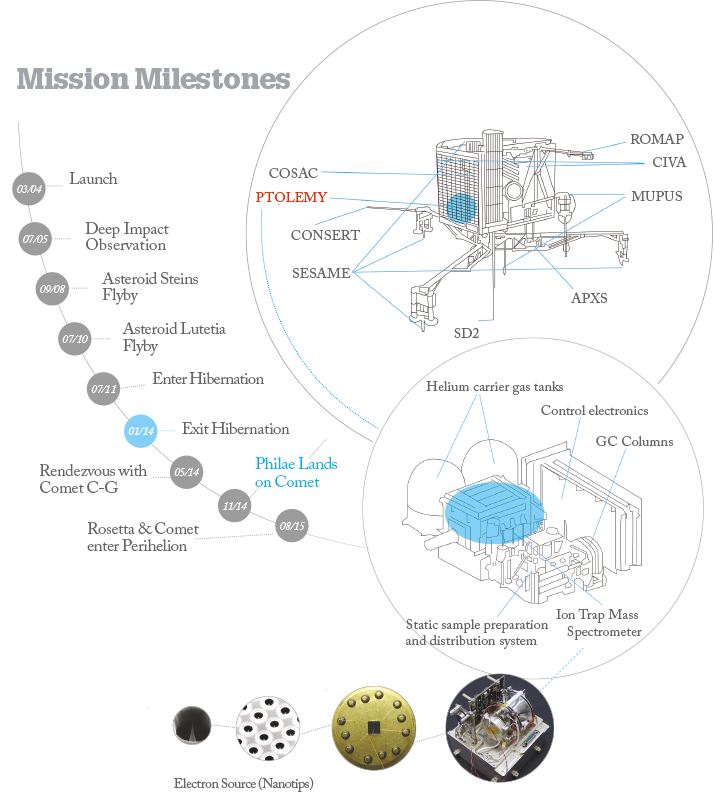
In 2004, the European Space Agency’s Rosetta Mission launched from French Guiana. Objective: to catch Comet 67P/Churyumov-Gerasimenko (discovered in 1969) and accompany it to the inner solar system. After ten years of nail biting, comet chaser Rosetta, now some 500 million miles away, has awoken from hibernation and phoned home. Meanwhile, Ian Wright (interviewed below), professor of planetary sciences at The Open University, UK, and principal investigator for the Ptolemy instrument, is patiently awaiting the first ever comet soft landing and his moment of glory. Ptolemy, part of the Philae Lander’s science package, is the size of a small shoebox, weighs under 5 kg, and contains the “miniaturized” gas chromatography-mass spectrometry system developed by Wright some years ago…
How do you feel about this once in a lifetime mission? “I’m not sure what the emotion is, but I am eternally grateful to my university and the UK funding agencies for giving me the chance to experience it. Of course, there is a certain amount of excitement, but I’m also hoping to experience the relief and gratification that comes with success. And although Rosetta is currently very much in focus, it is necessary to be thinking about the next part of one’s own “lifetime”; along the way I’ve done many things besides Rosetta, but it feels strange to be actively contemplating the next big project before this one has finished.” What were the main challenges in developing Ptolemy? “Bearing in mind the ten years that will have elapsed between launch and eventual arrival at the comet, I recall that the instrument was being put together just as the millennium bug was about to end civilization as we knew it. But I had personally started on the project more than ten years before that. Back then, the average UK household had a car running on leaded petrol, only five TV channels (satellite TV was a rarity), possibly a “computer” of some sort with a dial-up modem (operating, on a good day, at 0.01 Mbits/s) and, if business executives were in residence, a cell phone (something of brick-like beauty and appearance). It’s fair to say that some of the challenges for Ptolemy were the challenges of a previous era (or century) in addition to the overall timescale of the mission itself.”
What mission outcome would give you the greatest satisfaction? “In many ways there have already been rewarding outcomes; some of the people who had involvements with the mission now have interesting jobs and careers of their own. Furthermore, some of the expertise developed on the project has been, and continues to be, deployed in ventures that are either academically or commercially relevant. For those still actively working on Rosetta, the greatest satisfaction will be the return of some valid electromagnetic signals that ultimately have the capacity to convey some new scientific meaning and knowledge.”

In addition to Ptolemy (aka MODULUS: methods of determining and understanding light elements from unequivocal stable isotope compositions), the Philae surface science package (total mass 21 kg) also includes an alpha-proton-X-ray spectrometer to determine elemental composition, another GC-MS system (the cometary sampling and composition experiment or COSAC) for chemical analysis of core material, and a host of other acronymic wonders: SESAME: surface electrical, seismic, and acoustic monitoring experiments will acoustically investigate surface material and measure the environment’s dielectric properties. CONSERT: comet nucleus sounding experiment by radiowave transmission will measure electrical characteristics of the nucleus bulk material and internal structure. MUPUS: multi-purpose sensors for surface and subsurface science will study the comet’s physical properties. ROMAP: Rosetta lander magnetic field investigation and plasma monitor will investigate the comet’s magnetic field as well as its interaction with the solar wind. CIVA: Comet nucleus infrared and visible analyzer will characterize samples an record IR spectra Philae also boasts a couple of other in-situ imaging systems and the all-important sample drill and distributor (SD2), which feeds samples to Ptolemy, CIVA and COSAC. Let’s hope it all works after ten years in deep space.
For more information on Rosetta Mission: tas.txp.to/0114/Rosetta and Ptolemy: tas.txp.to/0114/Ptolemy.




